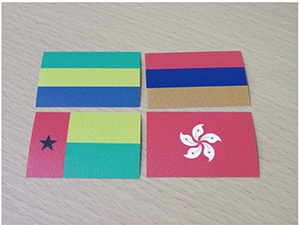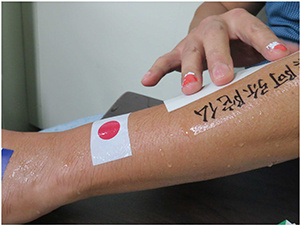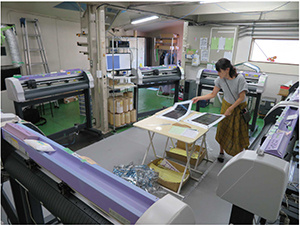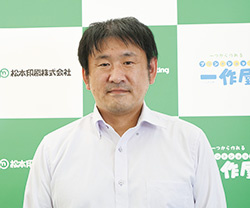Fully digitalize sticker and label production for higher profitability
Conclusive fact in introducing UCJV300-75
- Capability to produce stickers and labels in small lots
- Printable on any material
- Post-print processes also digitalized by the cutting plotter
“Digital Only” is our rule.

Established in 2015, Kapita, Co., Ltd. is a relatively new company among sticker and label printers. In recent years, it is rare for a printer to establish a new company. President Hirotaka Yanagimori, however, had a secret strategy. It was full digitalization of sticker and label production.
Mr. Yanagimori is well-known in the industry as a person who succeeded Kakuei Co., Ltd., a sticker and label print company, and promoted digital printing as its representative. While promoting digital printing at Kakuei, he thought he would like to take on the challenge of leaving analog print and trying production by digital process only, which made him establish Kapita by spinning it off from Kakuei to start a new business.
His serious involvement with digital print all started from the time he saw digital prints of other printing company. “In those days, inkjet printers were still new and not in wide use in the sticker and label industry. So I was quite curious. I like new things, and their production scene looked so cool compared to that of analog, which made me think I would like to try digital print in-house.” Mr. Yanagimori looks back.
Their relationship with Mimaki Engineering products started from “CJV30” in the days in Kakuei.
They introduced the latex-type inkjet printer (IJP) “JV400-130LX” 7 years ago, then introduced the UV-curable IJP “UCJV300-75” replacing “CJV30” in December 2018. Currently they use these 2 printers selectively for different applications. In addition, they operate over 20 cutting plotters such as “CG-75FXII” and “CF2-0907” as post processing devices.
Mr. Yanagimori values their functions, “We set a rule not to do any analog printing when we established the company. In the course of our business, Mimaki's inkjet printers are quite convenient to use.”
Advantage of digital print after gaining recognition
However, there were not many digital jobs right after the introduction. In many cases, the company received orders for small lot products from other print companies. Some print companies used to have strict quality standards and did not take up their products because “inkjet print produces a different texture from offset print.”
In recent years, however, characteristics of inkjet printer are widely recognized by print companies, and appreciated for its convenient use.
“In the early days, many of the orders were received in a situation like; “We want the actual production to be done by offset print, but want its samples produced by digital print because the volume is small.” Recently, we receive more orders from customers who say, “We love the texture, and want the actual products to be produced by inkjet printer as well.”” explains Mr. Yanagimori.

Colorful stickers of irregular shape like this can be produced from 1 sheet.
To produce stickers and labels, they generally print on adhesive paper rolls of 150-330mm in width using an analog printer, and half-cut them with a die cut machine. In this case, printing plates and die cut blades are required. If it is for full color print, at least 4 plates are necessary. In irregularly-shaped die cutting to cut the surrounding of a character shape, the blade becomes expensive. If a special color (specific color for corporate color, etc.) is used, they need to place a custom order of the ink.
Therefore, cost burden of plates, blades, inks becomes too high for a small-lot print such as 1000 or less volume, which made the production economically infeasible.
In digital printing of stickers and labels promoted by Kapita, they no longer require plates and blades, and the colors are expressed by mixing different inks, which makes it possible to produce stickers from the minimum volume of 1 sheet at relatively low cost.
Mr. Yanagimori explains, “Off course there is an economic lot size. The volume between 300 and 1,000 is the approximate scope covered by IJP.” They once received a large order of 20 thousand PR stickers from an automobile dealer. To fulfill this order, they made full use of IJPs for 1 week to print the stickers.
Initially, in digital print in the days of Kakuei, they mainly produced correction stickers by combining black-and-white laser printers and cutting plotters. Having introduced new printers including Mimaki products, they can now respond to full-color print needs, which enables them to print a variety of products such as sales and promotion stickers, product labels, and attention (caution) labels for industrial products.
Affordable “UCJV300-75”


The face stickers and tattoo stickers are applied to the skin using water. They look just like real tattoos.
Mr. Yanagimori explains that he chose “UCJV300-75” because “It was much less expensive than other companies' products, and provided higher cost performance.” Until then, UV-curable IJP of this size and print speed cost between 5-8 million yen even at the level of least expensive models. The affordability at the 2 million yen level was amazing.
There is an extra effect. As the printer employs UV ink, it enables to print on special materials, which was previously impossible. It realizes vivid printing expression even on media not well-supported by toner printers such as PET and foil. Because UV ink produces extremely deep and great colors, it is heavily used for POP labels, advertising stickers, and other applications that need strong expression.
When printed with UV ink, the “Face sticker*” and “Tattoo sticker” developed by Kapita also have vivid colors, and the colors and logos on the flags appear with bright clarity.
Showing the samples, Mr. Yanagimori describes, “UV ink realizes these deep colors that cannot be produced by solvent and latex inks. They are beautiful stickers, and we hope they will be hot sellers in the coming Tokyo 2020 Olympic and Paralympic Games.”
Another Mimaki machine “JV400-130LX” realizes flat and beautiful ink, which makes it useful for products requiring delicate print expression, explains Mr. Yanagimori.
*This printed product of Kapita has been verified and classified as safe through human patch test. If you produce products that come in contact with the human skin, you are responsible to outsource their human patch test.
Leave the post-print processes to cutting plotters

Cutting plotters placed around the operator
What's unique to Kapita is the cutting plotters placed around the operator. “It's always the punching process that tends to be a bottleneck.” mentions Mr. Yanagimori.
In analog printing of stickers and labels, “blades” are used for the die cutting process. In simple terms, blades are created by machining steel blades into the shape to be cut, then press it against the paper to cut out the shape. The processing speed is as fast as several meters to several hundred meters per minute. But stickers produced in small lots become very expensive due to the cost of blades.
On the contrary, use of a cutting plotter enables to produce such products at low cost even in small lots.
Processing speed of a cutting plotter is slower than a die cut machine, but you can cover it by using multiple cutting plotters. In terms of the machine price, an analog post-processing machine is expensive, ranging from upper 1 million yen to several tens of million yen. In comparison, the cutting plotter they introduced costs less than 1 million yen, which lowers the hurdles of initial investment.
Furthermore, analog printers require technical skills of craftsmen, and a craftsperson needs to sit in front of 1-2 units of such machines all day. In the case of plotters, they can be left unsupervised after setting, which allows an operator to work on the jobs by operating 6-7 units of the machines at the same time.
Rarity value of digital print professional

The factory is equipped with flatbed cutting plotters including CF2-0907.
Kapita was established with the firm rule of “No analog printing”. It is still hard to find a company that can digitally print and process stickers and labels at the satisfying level for print professionals. Such products have not fallen in prices compared to analog print, and are said to have high hopes for the future.
The company has boosted its business performance as a still hard-to-find digital specialist in the sticker and label industry, and has a plan to establish its 3rd factory in the near future from the necessity to secure more production base. It also expects to enhance online sales and develop new products following the face stickers.
Mr. Yanagimori talks about his vision, “Digital print has further significant growth potential. We will further promote digital print of stickers and labels while seeking Mimaki's cooperation.”
<Introduced products>
LED-UV Print & Cut Inkjet Printer: UCJV300-75
Inkjet printer (latex): JV400-130LX
Roll-type cutting plotter: CG-75FXII
Flatbed cutting plotter: CF2-0907
User profile
- NameKAPITA Co., Ltd.
- IndustrySale of seals, labels, and stickers
- Address6-37-9, Takamatsu, Nerima-ku, Tokyo, Japan
- Phone number+81-3-6904-5211
- URLhttp://kapita.co.jp/









